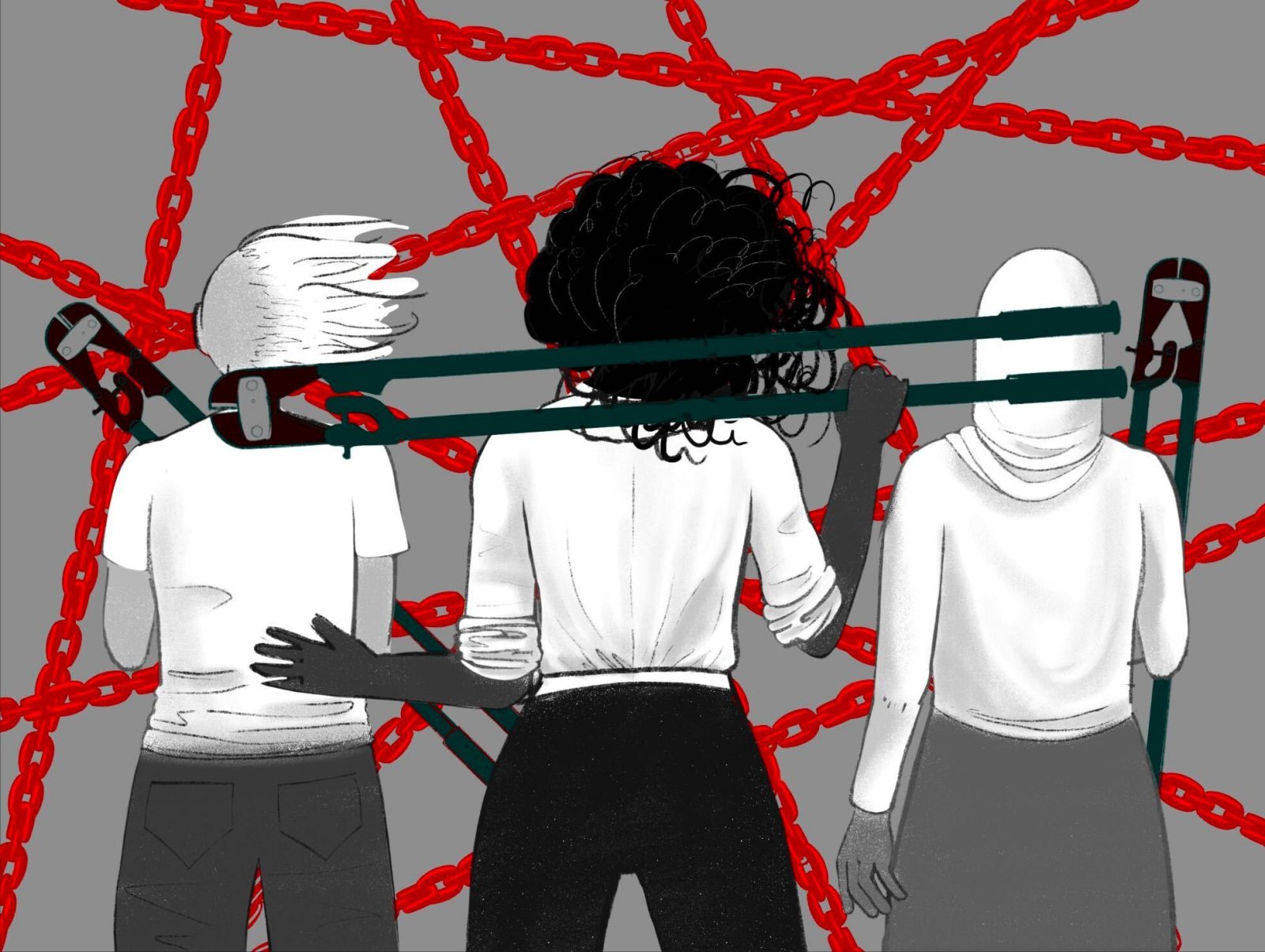In the early 2000s, I sat in an organizing meeting discussing how to prevent a new prison from being built. After listening to several people talk about ways our coalition could encourage the prison to be sited somewhere else or on a smaller footprint, I wondered aloud if we shouldn’t make a case for no prison to be built at all. This meeting sticks out in my mind in part because someone who should have been an ally discouraged me from talking about prison abolition, claiming that we needed to be realistic and couldn’t deal in “science fiction.” Similar conversations followed in meetings to organize against the violence of policing when I questioned if policing were necessary at all.
Twenty years later, it’s common to find myself among people whose introductions include identifying themselves as abolitionists. Even when I don’t fully understand what they mean by that, the identification represents a significant shift.
Prison–industrial complex (PIC) abolition is the political praxis that seeks to eliminate the use of surveillance, policing, sentencing, imprisonment, and execution and to build healthy, stable, self-determined societies that do not rely on coercion and vengeance to address harm. It’s important to note that detention and immigration policing are included in this understanding of the prison–industrial complex, as is mental health imprisonment, youth imprisonment, and so on. This is not a new praxis but rather one developed through struggle over decades. This praxis, previously rejected outright as utopian or science fiction, has recently become more widely accepted. From Twitter to the New York Times, PIC abolitionist ideas have pierced the mainstream. Catalyzed in part by the 2020 uprisings and fueled by many years of persistent organizing, more people have begun to question the legitimacy of the punishment system and to consider how much better life could be without it.

From the series
Abolition in Action
A collection of essays exploring how people are practicing abolition in their communities, in partnership with Truthout.
Let’s not get ahead of ourselves, though. PIC abolition is still marginalized and frequently misunderstood. Its somewhat increased popularity has been accompanied by a diffusion of the politics: it can be taken to mean anything from eliminating imprisonment to installing mutual aid pantries or making individual lifestyle choices. While an expansive understanding of abolition can be useful, a loose application has posed challenges to organizers mobilizing the politics in more focused, rigorous ways, suggesting an incorrect equivalence between disparate activities.
Additionally, mainstreaming an “anything goes” approach to this political praxis has made the context for PIC abolition organizing muddled. A generalized approach also opens the door for reformist approaches to masquerade as abolitionist ones, spurring conflict among allies who should more properly be fighting a common enemy. Specificity is essential for applying the politics effectively, and the lessons learned through practice only amplify the need for that specificity.
Beyond Ideology
Given the uphill task of moving PIC abolition from being understood as science fiction to being given serious consideration, it makes sense that PIC abolitionists have elevated ideological concerns above organizing ones in public contexts. Brilliant, mostly Black feminist thinkers have repeatedly articulated the contours of PIC abolitionist politics and made the case for their acceptance. Toolkits, fact sheets, op-eds, books, and webinars offering a variety of takes on the politics are increasingly available. And while dynamic ideological activity is essential to advance the politics, PIC abolitionist organizing campaigns provide the best case for the politics by demonstrating how to put them into practice. Grassroots campaigns to prevent the construction and expansion of prisons and jails; campaigns to eliminate the use of policing practices, from stop-and-search to gang injunctions; campaigns to stop the application of life sentences without the possibility of parole; and campaigns to abolish executions are just some examples of campaigns that deprive the PIC of the people, policies, and practices that legitimate and sustain it.
When these campaigns are successful, they provide evidence that PIC abolition is not science fiction and that our society will not crumble if the PIC isn’t maintained. While organizers select a point of vulnerability in the PIC to attack, the most skillful among them also keep the whole prison–industrial complex in mind as they develop their strategies and select their tactics. Considering the entire PIC also helps ensure that their campaigns in one area do not inadvertently make it more difficult to fight other aspects. Organizers demanding the release of elderly or infirm imprisoned people, for example, will be mindful to not suggest that prison is an appropriate place for any human beings to be held. Likewise, organizers fighting to eliminate the violence of policing will not suggest that “community control” structures or the prosecution of individual cops are appropriate means to do that.
Careful, Pragmatic, Collective, and Long-Term
Some of the most conspicuous PIC abolitionist organizing of the past few years has been around defunding policing. While not all defund campaigns have PIC abolitionist goals, those that do imagine the starvation of police departments as one of a set of steps toward eliminating policing altogether. Organizers have demonstrated that this area of campaigning requires much more than simplistic invest/divest thinking and surface shuffling that does not transform the violence of policing in any substantial way. This campaigning requires a sober, pragmatic assessment of how power operates within existing systems, an analysis of how to withdraw resources from policing without bulking up any other aspects of the PIC, and the skill to illustrate the distinctions between policing and safety. Defund campaigns are just a small portion of all abolitionist organizing, however. Regardless of the point of entry, the practice of advancing campaigns with a PIC abolitionist lens illustrates the care and tactical thinking necessary to effectively move toward abolitionist goals.
PIC abolitionist organizing also illustrates that this political praxis must operate beyond the scale of the individual, challenging those who would reduce the politics to individual lifestyle choices. PIC abolitionist organizers understand that coordinated, collective action is essential to eliminate the barriers to genuine well-being posed by the prison–industrial complex. Therefore, they typically run campaigns aimed at drawing a broad base of people into them.
More from our decarceral brainstorm
Every week, Inquest aims to bring you insights from people thinking through and working for a world without mass incarceration.
Sign up for our newsletter for the latest.
Newsletter
Further, transforming the current conditions—as steeped in the logics of punishment as they are—not only requires collective action but also long-term strategy. As such, PIC abolitionist organizers may reject short-term quick fixes in favor of long-term ones that result in a greater transformation of the conditions underlying the prison–industrial complex. To be clear, this choice need not require delaying relief as much as avoiding unnecessary traps. PIC abolitionist approaches do not ignore the immediate needs and concerns of people closest to the points of pain, but rather think creatively about how to bring relief without incurring additional harm from the PIC.
The Pudding’s Proof
If PIC abolitionists are to dispel the idea that our political aspirations are more than science fiction fantasies, putting them into practice is essential. A complete praxis—applying ideas to real-world situations, and adjusting those ideas based on what is learned from the application—gives us the best chance of understanding the viability of a world free from surveillance, policing, imprisonment, sentencing, and execution.
Organizing with a PIC abolitionist lens doesn’t mean compromising our well-being. It means testing out experiments in abolitionist world-making to understand which ideas, practices, and institutions give us the best chances and which aren’t up to the task. And organizers have been doing this for a long time. Organizers won moratoriums on prison construction and executions in the 1970s, and in more recent decades have prevented the construction and expansion of prisons and jails across the United States. They have also eliminated the use of sets of policing practices such as civil gang injunctions. These wins haven’t eliminated the PIC yet, but they have struck definitive blows that are still being leveraged for additional gains on the path to its complete abolition. Just like all transformational change-making, power structures come back and attempt to regain what they have lost. This back and forth is not unique to the movement for PIC abolition and should not be used as an indication that this praxis is not realistic or viable, but rather a sign that, as the old civil rights song reminds us, freedom is a constant struggle.
But practice helps us move closer to perfection. Putting our ideas into practice—allowing ourselves to try, fail, and try again—will be how we move closer to seeing our visions realized. PIC abolitionist organizing is that practice. The practice helps us test our ideas and builds our ability to assess conditions and develop strategies. It creates openings to forge meaningful alliances and learn how to work together. It provides opportunities for people most directly harmed by the PIC to exercise leadership. Most importantly, PIC abolitionist organizing is already happening. All day every day, PIC abolitionist organizers are taking steps to tear apart the PIC and leave more stable, self-determined communities in its wake.
If you’re not among our number, it’s not too late. There’s a campaign out there that needs your support. The pieces in this collection may help you figure out where to get started.
Image: MirrorUp/Unsplash

